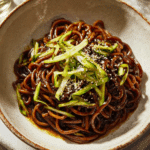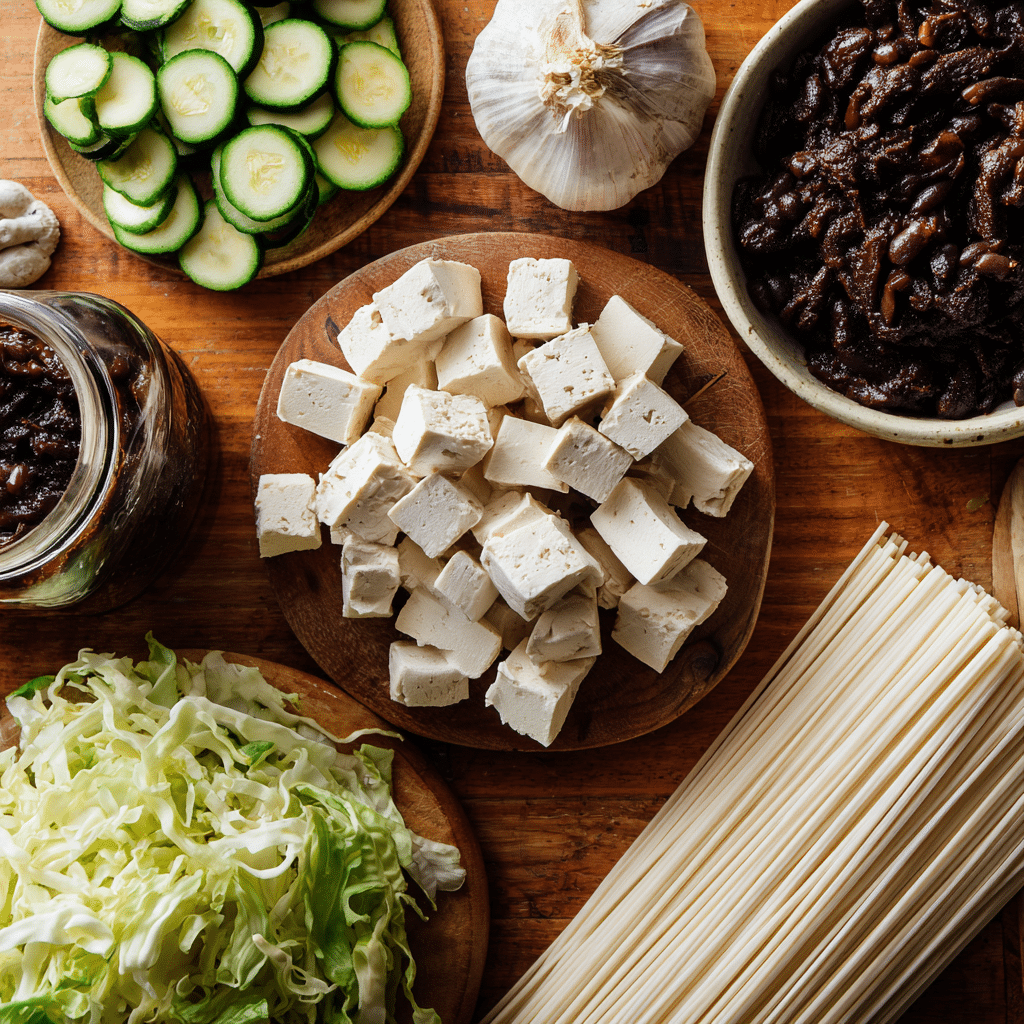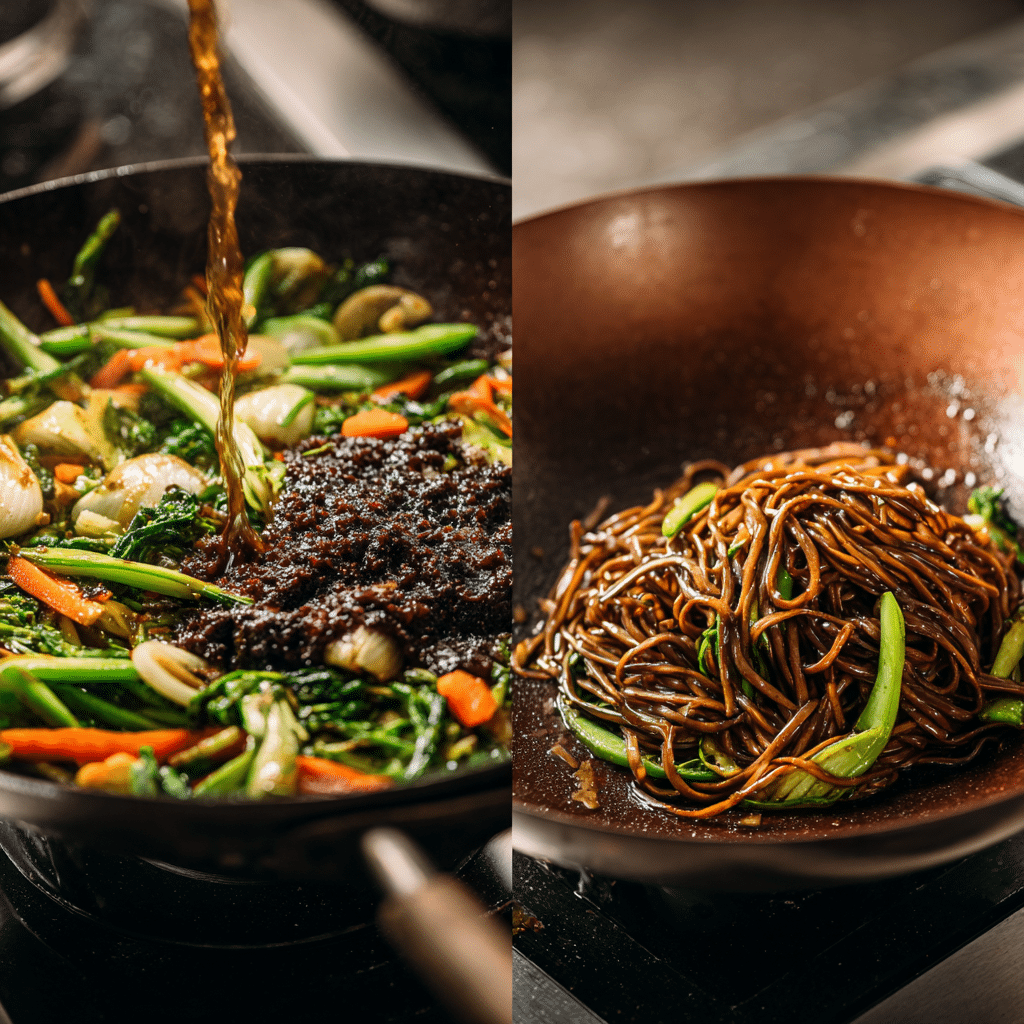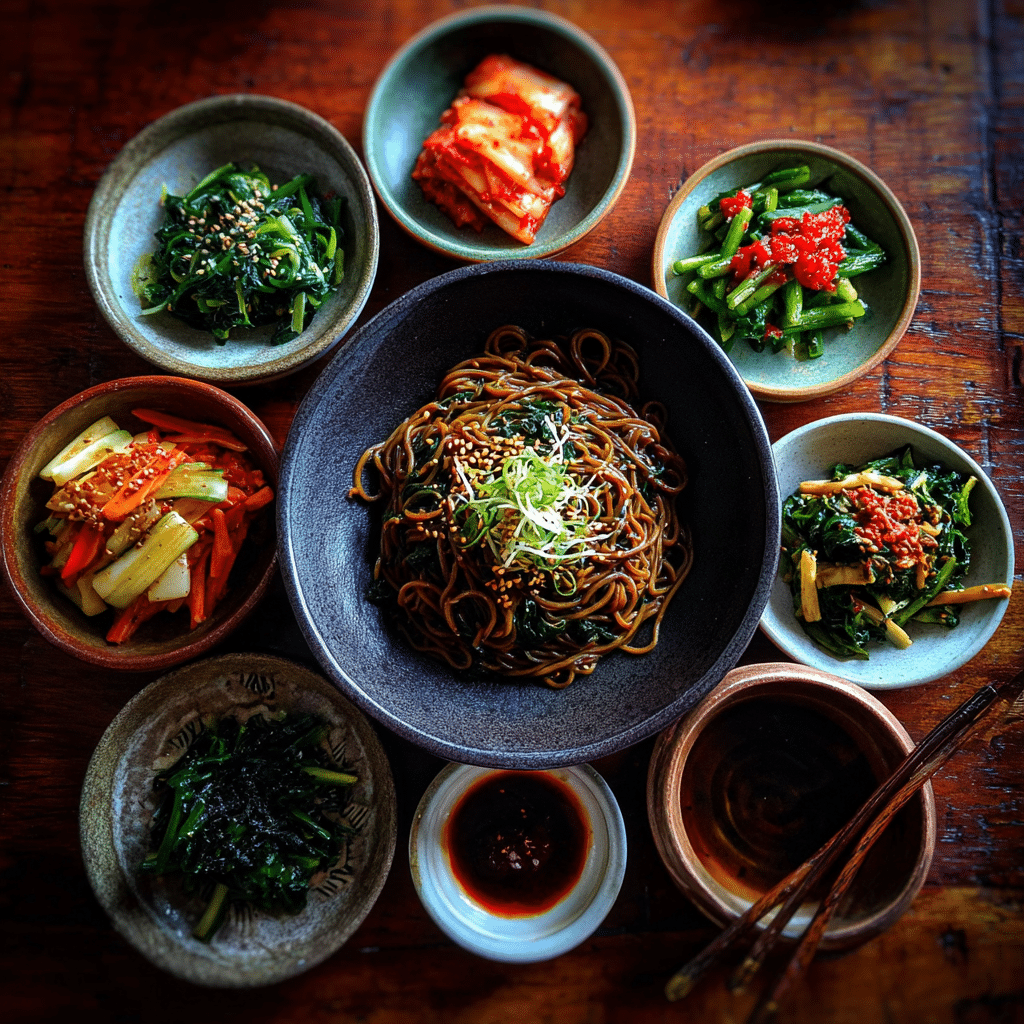There was a time when the idea of making anything like this black bean noodles vegetarian recipe would’ve sent me straight to the takeout app. I spent most of my twenties—and, let’s be honest, a good stretch of my thirties—depending on restaurant menus and microwave meals. Back then, cooking felt intimidating, like something reserved for people with more time, more confidence, or more natural talent than I had.
But eventually, I realized I wanted more than just convenience—I wanted a real connection to what I was eating. I wanted food that felt joyful, not just fast. That’s how I found my way into the kitchen, one imperfect meal at a time. And now, years later, dishes like this meat-free twist on Korean jajangmyeon are the kind of recipe that remind me just how far I’ve come.
This black bean noodles vegetarian recipe is cozy, bold, and packed with flavor—without the pork or the fuss. It’s a meal that’s easy enough for a weeknight but satisfying enough to replace your favorite takeout order. Whether you’re just starting out or rebuilding your relationship with cooking, this one’s for you.
Learn more about creamy dessert pairings like Cottage Cheese Chocolate Mousse to finish your dinner with something sweet and simple.


Black Bean Noodles Vegetarian Recipe That’s Better Than Takeout
- Total Time: 35 minutes
- Yield: 4 servings 1x
- Diet: Vegetarian
Description
This black bean noodles vegetarian recipe is a meatless take on Korean jajangmyeon—loaded with chewy noodles, a rich black bean sauce, and crisp vegetables. It’s bold, comforting, easy to customize, and comes together in just 35 minutes. Perfect for a cozy dinner that tastes better than takeout.
Ingredients
200g Korean wheat noodles or udon noodles
3 tablespoons Korean black bean paste (chunjang)
1 tablespoon neutral oil (vegetable, canola, or avocado oil)
1/2 yellow onion, diced
2 garlic cloves, minced
1 cup mushrooms (shiitake or king oyster), sliced
1 medium zucchini, chopped
1/2 cup cabbage, shredded
1 medium carrot, diced
1/2 cup vegetable broth or water
1 tablespoon soy sauce
1/2 teaspoon sugar (optional, to taste)
1 tablespoon toasted sesame oil
Optional toppings:
Julienned cucumber
Scallions or green onions
Toasted sesame seeds
Vegan kimchi
Pan-seared tofu or tempeh
Instructions
1. Prep your vegetables: Chop the zucchini, mushrooms, cabbage, carrot, and onion into bite-sized pieces.
2. Sauté aromatics: Heat oil in a skillet or wok over medium heat. Add onion and garlic, cooking until soft and fragrant.
3. Cook vegetables: Add mushrooms, carrots, and cabbage. Stir-fry for 3–4 minutes, then stir in zucchini. Cook until everything is tender.
4. Toast the black bean paste: Push vegetables to one side of the pan. Add a bit of oil and stir in the chunjang. Cook for 30–60 seconds.
5. Simmer the sauce: Mix the paste with the vegetables. Add broth or water, soy sauce, and sugar (if using). Simmer for 5 minutes. Drizzle with sesame oil.
6. Cook noodles: Boil noodles according to the package. Rinse under cold water to keep them springy.
7. Assemble: Divide noodles into bowls. Ladle sauce over the top. Add your favorite toppings and enjoy.
Notes
Make it spicy: Add gochujang, gochugaru, or chili flakes to the sauce.
Make it creamy: Mix in a splash of oat cream or coconut milk to soften the richness.
Gluten-free option: Use tamari instead of soy sauce and gluten-free noodles like rice noodles or shirataki.
Make ahead: Store sauce and noodles separately to maintain the best texture.
Storage: Refrigerate sauce in an airtight container for 3–4 days. Noodles can be steamed or reboiled for 30 seconds when reheating.
- Prep Time: 15 minutes
- Cook Time: 20 minutes
- Category: Dinner
- Method: Stir-fry
- Cuisine: Korean
Nutrition
- Serving Size: 1 bowl
- Calories: 420 kcal
- Sugar: 3g
- Sodium: 820mg
- Fat: 14g
- Saturated Fat: 2g
- Unsaturated Fat: 11g
- Trans Fat: 0g
- Carbohydrates: 55g
- Fiber: 6g
- Protein: 12g
- Cholesterol: 0mg
What Are Black Bean Noodles?
History and Origin of Jajangmyeon
Black bean noodles, or jajangmyeon, originated in Korea but were inspired by the Chinese dish zhajiangmian. Chinese immigrants in Incheon adapted their traditional fermented soybean noodle recipe using Korean black bean paste (chunjang), leading to the creation of a beloved Korean comfort food. Traditionally, it’s made with pork and served with pickled radish.
Over the years, jajangmyeon has become a symbol of Korean fast food culture and is especially popular on Black Day—a celebration where a comforting black bean noodles vegetarian recipe fits right in for solo dinners.
Traditional vs Vegetarian Jajangmyeon
The classic version uses fatty cuts of pork, but in a vegetarian black bean noodles recipe, we swap in umami-rich mushrooms or tofu for the same depth of flavor. Without the meat, this dish still packs plenty of punch thanks to caramelized onions, zucchini, cabbage, and garlic. The key remains the same: the dark, glossy black bean sauce that clings to every strand of noodle.
So while the core essence remains, this black bean noodles vegetarian recipe makes the dish more inclusive, lighter, and perfect for weeknight cooking.
Why Black Bean Noodles Vegetarian Recipe Is a Healthy Choice
Nutritional Value of Black Bean Paste and Whole Ingredients
The magic of this black bean noodles vegetarian recipe starts with the star ingredient: Korean black bean paste, or chunjang. Unlike the canned sauces often used in processed meals, this paste is fermented, rich in antioxidants, and offers a satisfying umami depth. It’s low in sugar and high in iron, copper, and magnesium, especially when you use low-sodium or homemade versions.
Pair it with fiber-packed vegetables like cabbage, zucchini, onions, and mushrooms, and you’ve got a bowl full of vitamins A and C, folate, and potassium. Whole ingredients give your body lasting energy and help support digestion, immunity, and heart health—making this black bean noodles vegetarian recipe both nourishing and flavorful. Instead of relying on processed meats or sodium-heavy broths, you’re letting plants do the heavy lifting with this vegetarian black bean noodles recipe—deliciously.
Let’s look at how the main ingredients stack up nutritionally:
| Ingredient | Key Nutrients | Benefits |
|---|---|---|
| Black bean paste | Iron, copper, antioxidants | Boosts energy and supports healthy blood |
| Zucchini | Vitamin C, fiber | Helps digestion and immunity |
| Mushrooms | B vitamins, selenium, ergothioneine | Anti-inflammatory and supports brain health |
| Cabbage | Vitamin K, folate | Supports heart health and bone strength |
| Onions & garlic | Antioxidants, sulfur compounds | Boost immune response and gut health |
| Udon or wheat noodles | Carbs, B vitamins | Provide energy and aid nervous system health |
So yes—this isn’t just comfort food. It’s comfort food with benefits.
Health Benefits of Plant-Based Alternatives Over Pork
Traditional jajangmyeon is typically loaded with fatty pork cuts, which may be delicious, but also come with saturated fats and high sodium levels. Swapping in tofu, tempeh, or mushrooms instead makes this vegetarian black bean noodles recipe not only meatless but far lighter on your digestive system.
By going plant-based, you’re also skipping the cholesterol, reducing inflammation risk, and supporting overall heart health. The fiber from the vegetables and whole noodles also helps stabilize blood sugar—making this dish diabetic-friendly when portioned wisely.
And here’s the best part: you’re not losing out on flavor. With proper caramelization of the veggies and a splash of good-quality soy sauce or sesame oil, this vegetarian version tastes just as indulgent as the original—but it leaves your body feeling more balanced.
Don’t miss our Navajo Cornbread Recipe if you’re looking for a fiber-rich, cozy side to pair with your noodles.
Ingredients for a Perfect Vegetarian Black Bean Noodles
Choosing the Right Noodles and Vegetarian Black Bean Paste
The backbone of any good black bean noodles vegetarian recipe is, of course, the noodles. Traditionally, jajangmyeon noodles are thick, chewy, and made from wheat. You can find them labeled as “Korean black bean noodles” in most Asian grocery stores. If you need a backup, fresh udon or thick spaghetti can get the job done. Just make sure not to overcook them—the goal is soft yet springy noodles that soak up the sauce without turning soggy.
Now, let’s talk sauce. Chunjang is the fermented Korean black bean paste that gives this dish its iconic flavor. Look for vegetarian versions to avoid hidden animal-based additives. If you’re soy-sensitive or just experimenting, a DIY mix of dark miso and a touch of molasses can give your black bean noodles vegetarian recipe a similar savory depth. The key step? Toast the paste in oil before using it—this unlocks its full richness and removes any sharp bitterness.

Must-Have Vegetables and Optional Protein Substitutes
This vegetarian black bean noodles recipe comes alive with crisp, vibrant vegetables—not just for texture, but for a boost of nutrition and natural sweetness. They’re not just fillers; they carry flavor and color that elevate every bite of your black bean noodles vegetarian recipe.
Core vegetables to include:
- Zucchini – Mild and hydrating with a soft bite.
- Cabbage – Adds sweetness and crunch when sautéed.
- Yellow onion – A rich base that deepens the sauce.
- Garlic – Essential for aroma and savory notes.
- Carrots – Slightly sweet with a nice snap.
- Potatoes (optional) – Hearty and grounding.
Plant-based proteins to bulk it up:
- Firm tofu – Pan-seared for crisp edges and protein.
- Tempeh – Dense with a nutty bite and satisfying texture.
- Mushrooms (shiitake or king oyster) – Offer a robust, savory chew that mimics the richness of meat.
Quick kitchen tips:
- Aim for even chopping when prepping veggies so everything cooks uniformly and nothing turns mushy.
- Pressed for time? A good-quality stir-fry veggie mix from the store can be a solid substitute.
Discover great ideas like our Parmesan Crusted Chicken with Creamy Garlic Sauce if you’re cooking for both plant-based and omnivorous eaters.
Step-by-Step Vegetarian Jajangmyeon Recipe
Preparing the Vegetables and Black Bean Sauce
Now we get into the heart of this black bean noodles vegetarian recipe—the cooking process. This dish is all about layering flavors, and that starts with properly prepping your ingredients.
Begin by washing and cutting all your vegetables. For best results, go for a medium dice. This helps create a uniform texture across the dish and ensures everything cooks evenly. Cut the zucchini, onion, cabbage, and carrot into small, bite-sized chunks. Slice mushrooms slightly thicker to preserve their “meaty” bite during the sauté. If you’re using potatoes, soak them briefly in cold water to reduce starch and prevent sticking.
Add a few tablespoons of light cooking oil to a large skillet or wok, and set it over medium heat until the oil shimmers. Toss in the onions and garlic first, letting them soften and release their aroma. After a couple of minutes, add the rest of the chopped vegetables—starting with firm ones like carrots or potatoes—and stir-fry until they begin to soften and develop a bit of color.
Once your vegetables are nearly cooked, slide them to one side of the pan to create space. Pour a small amount of oil into that space and stir in 2–3 tablespoons of black bean paste (chunjang). Allow it to cook undisturbed for about a minute to deepen its flavor, then stir it into the vegetables until evenly coated.
Add a splash of water or vegetable broth to loosen the sauce and bring everything together into a well-balanced black bean noodles vegetarian recipe. Let the mixture simmer for around 5 minutes so the flavors can meld. To balance the saltiness of the paste, you can stir in a small pinch of sugar and finish with a drizzle of toasted sesame oil for nutty richness.

Cooking and Assembling the Dish Properly
While the sauce is simmering, bring a pot of water to a boil and cook your noodles according to the directions on the package. Once cooked, strain and run them under cool water—this step halts the cooking and keeps the texture springy and pleasant.
To serve your black bean noodles vegetarian recipe, arrange the noodles in deep bowls and generously spoon the hot black bean sauce over the top. Garnish with thin cucumber strips, scallions, or sesame seeds for added freshness and crunch.
The beauty of this vegetarian black bean noodles recipe is how customizable it is. Want extra protein? Add pan-fried tofu cubes. Craving heat? Stir in a spoonful of gochujang or crushed red pepper to give your black bean noodles vegetarian recipe a spicy kick. It’s your bowl, your way.
Looking for inspiration? Try our Sugar-Free Lemon Blueberry Pudding Cake for a refreshing finish after a rich noodle meal.
Tips to Customize Your Black Bean Noodles Vegetarian Recipe
Gluten-Free and Low-Carb Variations
What’s great about this black bean noodles vegetarian recipe is how adaptable it is to fit different lifestyles. If you’re aiming for a gluten-free option, ditch the wheat-based noodles and go for something like rice noodles, brown rice ramen, or even shirataki. Just double-check that your black bean paste is gluten-free—or better yet, make a homemade blend with tamari, miso, and molasses for a safe and tasty swap.
Looking for low-carb alternatives? Try using zucchini that’s been spiralized into noodles, spaghetti squash strands, or any noodle substitute made with konjac. These lighter bases still work beautifully because the sauce in this black bean noodles vegetarian recipe is packed with umami and richness—it clings well without relying on heavy carbs.
This black bean noodles vegetarian recipe shows that bold flavors don’t have to be off-limits when you’re eating clean or adapting to dietary needs.
Making It Spicier or Creamier
This black bean noodles vegetarian recipe really shines in how flexible it is. Want to crank up the heat? Stir in some Korean chili paste (gochujang) while the sauce is simmering, or toss in chili flakes for a sharper kick. A bit of hot sesame oil added right before serving layers in a subtle heat and nuttiness that deepens the flavor.
On the flip side, if you’re in the mood for something smoother, you can mix in a splash of coconut milk, almond cream, or oat-based creamer to round out the saltiness and mellow the intensity. The result is a more luxurious, velvety texture that still lets the black bean base shine.
Don’t stop with the sauce—your toppings can take things to the next level. Think chopped scallions, crushed roasted peanuts, sliced cucumber, or tangy pickled radish. If you’re staying vegan, pan-seared tofu or crispy tempeh adds a nice protein punch and great contrast.
However you decide to flavor it, this black bean noodles vegetarian recipe gives you room to experiment while keeping the soul of the dish intact—and that’s what makes it a go-to meal in any home kitchen.
Don’t miss our cozy Protein Brownies if you’re craving something sweet to finish off your meal.
Best Side Dishes and Toppings for Black Bean Noodles
Classic Korean Banchan to Serve with Jajangmyeon
To round out your black bean noodles vegetarian recipe, consider adding some Korean-style side dishes that contrast and complement the rich, savory sauce. These small, flavorful additions enhance the meal and give it that full Korean table experience.
In traditional Korean meals, banchan—or assorted side plates—offer a variety of textures and flavors to balance the main dish. While jajangmyeon is hearty and deeply savory, these sides provide crunch, spice, or a cooling effect that keeps the dish interesting from start to finish.
Here are a few vegetarian-friendly banchan options that pair beautifully:
- Vegan Kimchi – Spicy, fermented, and tangy, it’s the perfect counterbalance to the black bean sauce.
- Sweet pickled radish (danmuji) – Its subtle sweetness and snap give your tastebuds a refreshing reset between bites.
- Garlic spinach salad (sigeumchi namul) – A delicate side made with wilted spinach dressed in sesame oil, soy sauce, and minced garlic.
- Lightly seared tofu – A simple protein option that adds creaminess and contrast.
- Spicy marinated cucumber – Cool, crunchy, and just a bit fiery—ideal with warm, saucy noodles.
These sides don’t just round out your plate—they elevate your black bean noodles vegetarian recipe into a true Korean-inspired meal that’s colorful, balanced, and satisfying.

Creative Toppings and Garnishes
The beauty of this black bean noodles vegetarian recipe lies in the layers—and toppings let you add even more. From crunch to freshness, your finishing touches can take it from delicious to unforgettable.
Try these ideas:
- Thinly sliced cucumber or carrots – Bright and crisp, perfect for topping off a rich sauce.
- Green onion curls or chopped scallions – These bring a clean sharpness that lifts the entire bowl.
- Roasted sesame seeds – Add a light crunch and warm, nutty aroma to every bite.
- Chopped peanuts or crushed cashews – Boost texture and bring a little extra richness.
- Crispy pan-fried mushrooms – Enhance that deep umami flavor with a satisfying bite.
If you want to add even more dimension, top with a soft-cooked egg or marinated tofu cubes. Vegan eaters can try fermented veggies, seasoned tempeh, or even spicy kimchi right on top.
Check out our Blueberry Coffee Cake Recipe for a comforting, not-too-sweet dessert that finishes the meal on a cozy note.
How to Store and Reheat Leftover Jajangmyeon
Proper Storage Techniques to Preserve Flavor
Making extra servings of your black bean noodles vegetarian recipe is always a good idea—it’s just too tasty not to enjoy again. To keep your black bean noodles vegetarian recipe fresh, store the sauce and noodles separately. This prevents the noodles from becoming overly soft or soaking up too much of the sauce overnight.
Spoon the black bean sauce into a sealed glass or BPA-free container and place it in the fridge. It’ll stay good for about 3 to 4 days. If your sauce includes tender ingredients like zucchini or tofu, it’s best to consume it sooner for the best texture and flavor. As for the noodles, give them a light rinse after cooking, toss with a touch of oil to prevent sticking, and store them in a separate airtight container.
Want to save it longer? You can freeze the sauce portion of your vegetarian black bean noodles recipe without issue. Portion it into freezer-safe containers and store for up to two months. When you’re ready, simply reheat and pair with freshly cooked noodles for a quick, satisfying meal.
Best Way to Reheat Without Drying Out
To keep the texture of your black bean noodles vegetarian recipe just right, it’s best to reheat gently and with a little added moisture.
For the sauce, warm it on the stovetop over medium-low heat and add a splash of broth or water while stirring. This keeps it from drying out and restores its silky texture.
For the noodles, drop them into boiling water briefly—just 30 to 45 seconds—or steam them until they’re warm. Reheating without moisture, like using a microwave alone, often leads to tough or uneven results, so it’s worth taking a minute to reheat properly.
Feeling creative with leftovers? Use any extra black bean sauce from your vegetarian black bean noodles recipe as a savory topping for rice bowls, roasted vegetables, or stuffed bell peppers. It’s a versatile base that can turn even plain ingredients into something exciting.
Check out our spin-worthy Zepbound Recipe Shortcuts for more ways to transform leftover components into fresh new meals.
Common Mistakes to Avoid in Black Bean Noodles Vegetarian Recipes
Overcooking Noodles or Burning the Black Bean Paste
One of the quickest ways to ruin a great black bean noodles vegetarian recipe is by overcooking your noodles. You’re aiming for a chewy, slightly firm texture that holds up well to the thick, rich sauce. Cook them just until tender, then rinse with cold water to stop the cooking process and prevent clumping.
Another common error? Mishandling the black bean paste. If the pan is overheated or you leave the paste unattended, it can quickly scorch, making the sauce taste bitter instead of savory. To avoid this, heat the paste gently in oil and stir it right away—this unlocks the umami depth without burning the base.
Skipping Steps That Build Flavor
Rushing through your black bean noodles vegetarian recipe might save time, but it often leads to a dish that falls flat.
Take a few extra minutes to let your onions and garlic reach a golden-brown stage. This builds a natural sweetness and boosts the overall flavor of the sauce.
Allowing the sauce to simmer is just as crucial. Those additional minutes help the ingredients fully blend, creating a cohesive, satisfying taste that clings beautifully to the noodles.
Another detail people often skip is tasting and adjusting the seasoning. A splash of soy sauce, a pinch of sugar, or a drop of sesame oil at the end can bring everything together in the best way possible.
And remember: good cooking is about layers. Add your ingredients step by step—start with aromatics, then add vegetables, then bring in your sauce. This simple structure adds noticeable depth to your black bean noodles vegetarian recipe.
Learn more about layered cooking strategies with our Corned Beef Instant Pot Guide and see how timing shapes flavor in a big way.
Vegan vs Vegetarian Jajangmyeon: Key Differences
Understanding Key Swaps for a Full Vegan Version
While this black bean noodles vegetarian recipe already skips the meat, going fully vegan means taking an extra step—avoiding any animal-based ingredients completely. That includes watching out for hidden elements like eggs in the noodles or seafood extract in black bean paste.
Most traditional chunjang pastes are fermented with caramel and sometimes anchovy or oyster derivatives, so double-check the label or choose one marked “vegan.” If you’re making the paste from scratch, stick to fermented black soybeans, molasses, and miso for that deep, savory base.
Another easy vegan switch? Use noodles made from rice, sweet potato starch, or other egg-free alternatives. Many Korean noodles used in vegetarian black bean noodles recipes are naturally vegan, but it’s always good to confirm.
Toppings like soft-boiled eggs and certain kimchi brands (which often use shrimp paste) should also be skipped in a vegan version. Instead, go for sliced cucumbers, spicy tofu, or vegan kimchi made with kelp or mushroom broth.
Store-Bought vs Homemade Vegan Black Bean Paste
There are pros and cons to both store-bought and homemade versions of the sauce used in a black bean noodles vegetarian recipe. Pre-made vegan black bean paste is quick, convenient, and consistent in flavor. It’s perfect when you’re short on time or new to Korean cooking.
However, if you’re chasing purity or avoiding preservatives, making it from scratch is incredibly rewarding. You control every ingredient—fermented black beans, garlic, sesame oil, soy sauce—and can adjust the taste to suit your preferences. You also avoid excess sodium and hidden fillers.
Homemade versions tend to be milder, slightly less salty, and fresher in taste. Once you get the hang of it, having a jar of homemade vegan black bean paste on hand can urn any stir-fry, rice bowl, or noodle dish into a flavorful, plant-based win—especially when made with this black bean noodles vegetarian recipe as the base.
Whether you’re sticking to vegetarian or going fully vegan, this black bean noodles vegetarian recipe is incredibly adaptable and satisfying. It’s one of those meals that grows with you—whether you’re just learning to cook or deep into your plant-based journey.
Don’t miss our Homemade Mounjaro Recipe with Pink Salt for another health-focused, creative plant-based meal idea.
Conclusion
There’s something incredibly satisfying about making your own black bean noodles vegetarian recipe from scratch. It’s not just about skipping takeout—it’s about creating a bold, nourishing meal that feels just as comforting as it does empowering. Whether you’re new to the kitchen or deep into your plant-based journey, this dish checks all the boxes: hearty, flavorful, and endlessly customizable.
With the right ingredients and a few simple techniques, you can master this vegetarian take on jajangmyeon and make it part of your regular dinner rotation. Don’t be afraid to experiment—try new toppings, swap in seasonal veggies, or make it fully vegan. This vegetarian black bean noodles recipe is designed to adapt to your taste and lifestyle with ease.
More than anything, this recipe is a reminder that cooking at home can be just as rewarding as the food itself. It proves that even a humble bowl of noodles can offer cultural depth, comfort, and creativity—all in one delicious experience.
Looking for your next plant-powered meal? Try our Lemon Balm Tea Recipe for Weight Loss to keep your wellness journey going strong.
If your kitchen needs a muse, scroll our Pinterest. If your mind craves the method, explore Medium.
FAQs About Black Bean Noodles Vegetarian Recipe
Are black bean noodles healthy?
Yes, black bean noodles can be a healthy meal, especially when made using a vegetarian or vegan approach. This black bean noodles vegetarian recipe includes nutrient-rich vegetables, plant-based protein, and fermented black bean paste, which adds beneficial gut-friendly bacteria. Compared to takeout versions that are often heavy in oil and sodium, homemade recipes give you full control over ingredients and portion sizes.
Can jajangmyeon be made vegetarian?
Absolutely. In fact, this entire article walks you through a simple and satisfying vegetarian black bean noodles recipe—a meat-free take on the Korean classic, jajangmyeon. By replacing pork with mushrooms, tofu, or tempeh, and using vegan or vegetarian black bean paste, you can enjoy all the flavor without the meat. It’s a perfect plant-based meal option that doesn’t sacrifice richness or depth.
What pairs well with black bean noodles?
Great question. A black bean noodles vegetarian recipe pairs beautifully with traditional Korean banchan like kimchi, pickled radish, seasoned spinach, or even crispy tofu. You can also serve it with miso soup, a cold cucumber salad, or a simple sesame-dressed side dish for contrast. The goal is to balance the savory, earthy sauce with something light, crunchy, or spicy.
How to make black bean noodles without pork?
To make a flavorful black bean noodles vegetarian recipe without pork, simply swap in ingredients that offer a similar meaty texture and umami flavor. King oyster mushrooms, tempeh, firm tofu, or seitan all work well. Cook them until golden to bring out a richer taste, then add them to your sauce just as you would with meat. You won’t miss the pork when the seasoning and paste are balanced.

